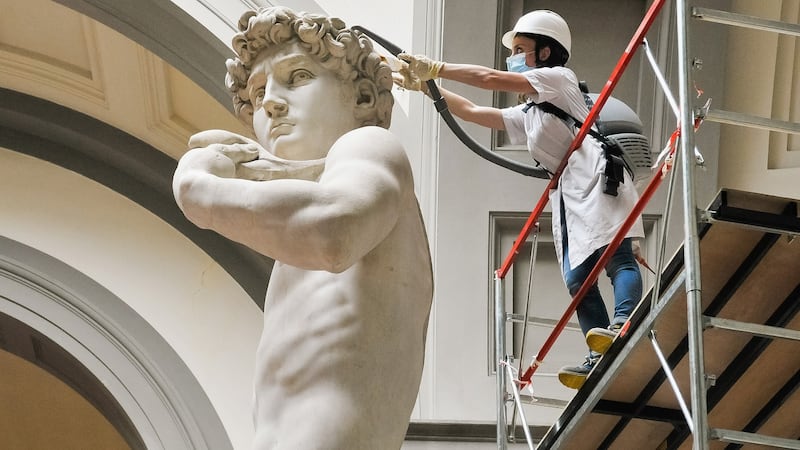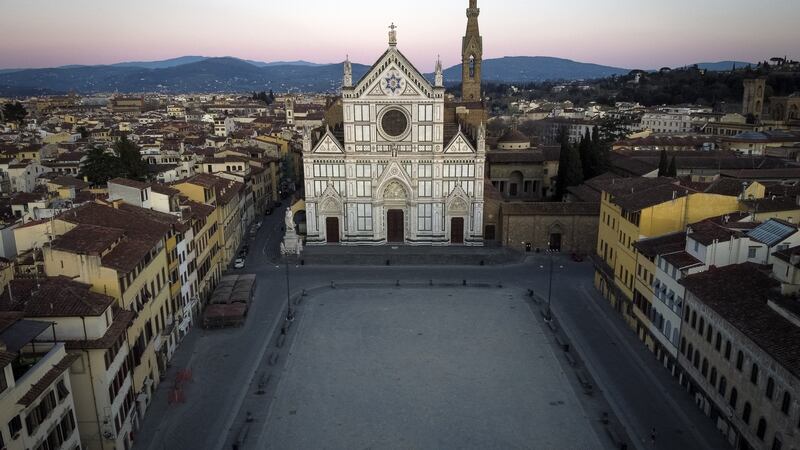Paolo Risica is busy. Handing out menus, taking orders, answering questions about the food.
Hostaria Bacanera, the restaurant he runs with his partner Eleanora Brocca in Venice’s Cannaregio district, is booked solid almost every night. On my first night in town, I wander in hoping to get a table, but Eleanora gives me one of those sympathetic smiles that also express incredulity. She then hands me their business card and suggests that I call to make a reservation for another night.
It’s been like this pretty much since the city reopened on June 3rd, Paolo tells me when I eventually did get a table, outside on the Campiello de la Cason. This quiet residential square is hidden in plain sight only a five-minute walk from the Rialto Bridge, yet the clientele is almost exclusively local – which has guaranteed a steady trade since the end of lockdown.
However, Hostaria Bacanera - and a handful of other spots scattered throughout the city – are the exception, as most restaurants are struggling badly due to lack of visitors. Around a third of them haven’t reopened since the end of lockdown, while those that have are left with empty tables almost nightly.
“Most restaurants are living day by day,” says food blogger Monica Cesarato. “It’s very hard to organise supplies as restaurants have no idea whether they’ll be empty today or get a lot of day trippers.”
Walking around the quiet streets in the evening, I am constantly beckoned by waiters offering me a table wherever I want, inside or out.
The hotel sector is hit just as badly, with only 70per cent of hotels reopening their doors. Occupancy rates are alarmingly low – as low as 15 per cent for some. At the Hotel Giorgione, an elegant four-star in Cannaregio, rates have climbed as high as 70 per cent, but manager Marisa Milanese paints a sombre picture.
“Once lockdown was announced we thought we’d only be closed for a couple of weeks,” she says with a smile. “And when we finally reopened on May 28th it was an act of enormous courage as we had absolutely no idea how we would manage to survive.”
A couple of months on and they are surviving, but only by slashing their rates to low-season prices and relying almost exclusively on last-minute bookings. “We will operate at a loss this summer, but at least we’re still here.”
Claudia Scarpa, director of the Venetian Association of Hoteliers, is equally bullish. “Hotels are reopening out of a sense of civic duty, because the city has to take off again and attract international visitors, just like museums and restaurants are. Let’s hope that the situation improves in the future, and that by spring 2021 the coronavirus will be nothing but a bad memory.”
In the meantime, Venice has to deal with the near total collapse of visitor numbers. Along with Florence and Rome, the city is one of Italy’s major città d’arte - museum cities - that are responsible for around a third of Italy’s tourism GNP but have been most severely impacted by Covid-19.

Venice is the worst hit because it is the most heavily dependent on tourism: 65 per cent of its residents are employed directly in the tourist industry, and according to the mayor’s spokesperson for tourism, Councillor Paola Mar, the most optimistic prediction for 2020 is that visitor numbers will be around 20 per cent of normal.
In Venice, though, normal is made up of some pretty staggering figures: the historic city has a population of 53,000 but plays host to over 26 million visitors a year. It’s like Dublin, with its 1.3 million people, had to deal with an additional 676 million extra bodies.
Venice is no stranger to crisis – the word ‘quarantine’ was coined here in the 15th century in response to the Black Death, when plague-ridden ships had to wait 40 days – una quarantena in Italian – before being allowed to dock. In the centuries that followed the city has been visited by over 20 outbreaks of plague, including a particularly vicious one in 1576 that killed half the population – and gave local artists like Tintoretto a suitably grand – if grim – subject matter to work with.
The most obnoxious examples of Venice's surrender to mass tourism are the grandi navi, the big ships
The Scuola Grande di San Rocco, named after St Roch, the patron saint of plague victims, is home to some of Tintoretto’s most dramatic work, a series of 50 ceiling panels titled ‘Heaven on Earth.’ At any other time, getting to see these paintings (whose overarching theme is the search for hope in a time of despair) is an exercise in patience and crowd control, but when I visited there was barely a dozen people in the vast room.
The Doge’s Palace, which ordinarily sees tens of thousands of daily visitors, welcomed under 1000 the day I went, according to Simona at the ticket desk.
Florence
In Florence, museums were slow to reopen, with many leaving it until near the end of August. Here too tourism has tanked badly – down to between 20-30per cent of the 16 million that visited in 2019, according to Francesco Palumbo, director of Toscana Promozione, the Tuscan tourist board.
To make matters worse, July and August saw the annual exodus of Florentines away from the sweltering heat of the city for the seaside and mountain resorts of Tuscany. In any other year, August belongs to the mass of international visitors; this year, there was only a trickle of visitors from the EU and other parts of Italy.
Like Venice, Florence’s hotels have been hit hard. Chiara Pelagotti is the chairperson of the Associazione Impresa Ricettive-Città d’Arte (AIRCA), a group that represents 220 of the city’s 1500-odd varied accommodations, including B&Bs, historic homes and hotels.
She tells me that 60 per cent of the city’s accommodations are still closed, including most of the top-end hotels that usually rely on convention tourism and visitors from outside the EU. And while some hotels will open in September (to take advantage of the Formula 1 Tuscan Grand Prix, which is being run at the Mugello track just outside the city), they’ll close again in October.
Most of her members that are open are getting a fraction of the numbers they would ordinarily get. This includes Francesca Alfani (a relative of this writer), whose family-run Palazzo Alfani is a self-catering residence in a historic palazzo directly opposite the Museo dell’Accademia (home to Michelangelo’s David). Her annual occupancy rate runs around 75 per cent: in 2020, she predicts it’ll be 14 per cent.
As the son of a Florentine mother, I’ve been coming here all of my life and I haven’t seen the city this empty since the 1970s. But the most notable difference is that then visitors shared the historic centre with a thriving local population, whereas today most locals have abandoned the centre for the suburbs, and virtually every retail outlet is geared toward tourism.
There are a few stalwarts, however. Gianni Iacovitti has managed Ristorante Accademia on Piazza San Marco for 24 years. He serves a mix of Italian and Florentine classics that have earned him a loyal following: in high season, his clientele breaks down roughly into 60 per cent tourists, 40 per cent locals; in low season, the ratio is reversed.
He reopened on May 18th, and for the first few weeks, customers and staff alike were frightened and insecure. “Everyone felt disoriented,” he told me, “as if nobody could quite figure out if they were doing something wrong or not. Nobody really knew the new rules.”

Over the past three months, he has operated at between 20-30 per cent of normal, and doing almost no business at lunchtime. “There’s nobody around during the day. There are no tourists, most locals have gone to the beach or the mountains, and of those that stayed, everyone is engaged in smartwork [what Italians call working from home] so there’s nobody in the city centre.”
Reliance on tourism
Yet for many in both Venice and Florence, the Covid-19 disaster has also prompted a day of reckoning for the unhealthy over-reliance on a tourist monoculture that has severely damaged the social fabric of each city and reduced both to little more than open-air museums.
If Florence is a troubling example of the perils of over-tourism, Venice is drowning in the tourist tide. The population has halved since the mid-70s, with most forced to move to mainland Mestre, chased out by crumbling services and the lack of affordable housing due the unregulated growth of home-rental options.
The city’s artisans and traditional sellers are disappearing, replaced by fast-food shops, tourist restaurants and shops selling cheap, foreign-made versions of traditional Venetian goods. In the famous Rialto market, the number of stallholders has fallen by two-thirds in the past 20 years.
But the most obnoxious examples of Venice’s surrender to mass tourism are the grandi navi, the big ships: every day between April and September, 13 large cruise ships enter the lagoon, displacing huge amounts of water that cause serious damage to the fragile foundations of the city. After years of action and protests by local groups, in 2019 the Italian transport minister Danilo Toninelli announced an impending ban on all big ships from the lagoon.
But many Venetians are sceptical that the ban will actually be enforced. Paola Mar acknowledges the environmental devastation wrought by cruise ships but argues that opponents overstate their impact on tourism numbers.

“The ships bring in 1.7 million visitors a year, of which 70 per cent stay a night or two either before boarding or after disembarking – that’s 900,000 who are overnighting [sic: 70 per cent of 1.7 million is 1.19 million]. The main issue is the 15 million or so day-trippers who come from the beach resorts of the Adriatic, spend four or five hours in the city and then leave without spending any money.”
Paola Mar points to Mayor Luigi Brugnaro’s 2017 action plan that addresses many of the major issues, but Paolo Risica says he’s heard it all before and is doubtful anything will change. Monica Cesarato, who thinks the way forward is to incentivise the city’s artisans and work toward a 50-50 revenue balance between traditional craft sales and tourism, is equally sceptical, especially as the city is preparing for mayoral elections on September 20th-21st.
“We don’t want this devil,” she says with a thin smile, “but Brugnaro is popular with voters in the wider region and he won’t risk losing their votes by doing anything that might cost the city tourism revenue.”
Florence of the future
Cesarato thinks Florence has a better handle on the perils of over-tourism. While Florence doesn’t have to deal with crumbling foundations or cruise ships on the Arno, the pressing issue is the concentration of visitors in the 5 sq km area of the historic centre.
Tourism councillor Cecilia Del Re says that decentralisation is the key to a more sustainable form of tourism, along with a greater focus on local artisans rather than tourist shops.
“The Florence of the future must be increasingly intelligent, sustainable, inclusive and green,” she tells me. As an example, she points to Dolce & Gabbana’s most recent runway show at the beginning of September. In collaboration with local authorities, the focus was not on clothes but on the work of 38 local artisans, from tanners to gold-beaters, whose expertise is used in the fashion label’s designs.
But, like in Venice, local government’s commitment to doing something concrete about its issues raises plenty of eyebrows. “The future is all well and good,” says Chiara Pelagotti, “but what about the here and now? A few months ago, we petitioned the municipality to consider assistance with marketing, a stay on local property tax and lowering the city tax charged on all hotel bookings. Three months later, we haven’t heard a thing.”
Back at the Ristorante Accademia, I asked Gianni Iacovitti if he is optimistic.
“My staff is on state aid. I’m using up all of my savings to pay the electricity bill and the rent, which was cut to 60 per cent until the end of September. After that, we’ll see what happens. I don’t know how long I can go on, but I’ll go on as long as I can.”


















